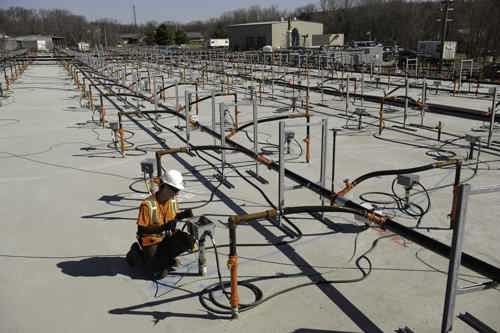You have carefully characterized the site, evaluated remedial technologies, and determined that in situ thermal remediation (ISTR) is the best option. The next step is to send out a request for remediation proposals (RFP) – but what do you need to include to ensure you select the right contractor and technology? What are the RFP process steps you should be following?
In this two-part blog post series, you’ll learn what information to include in your RFP to get the best responses from your thermal contractors. In this first installment, I’ll cover what technical information to include in the RFP to help you identify and select the best technology and approach for meeting your project’s goals. Part 2 will address how to save money on your ISTR project by requiring achievement of mission-critical criteria, and carefully considering whether secondary criteria and contract requirements provide added benefit for the cost.
Let’s dive into three common questions about the RFP process steps for thermal remediation services.
In the RFP, should you specify the thermal technology you want the contractor to use?
When you begin building your RFP, you may have ideas about which ISTR technology is most suited to meet your site’s remedial goals—and you may be 100% correct.
Thermal contractors, however, have many years of experience working on a variety of sites, and may be able to provide you with cost-saving solutions you haven’t thought of. It’s smart to allow thermal experts to evaluate your site and determine which heating method (or combinations of methods) they feel provides the best fit.

That doesn’t mean you have to blindly trust them, though. In the RFP, ask them to clearly describe their technology selection process (why this and not that) and identify the benefits of their proposed approach to addressing site conditions and meeting your remedial objectives. This will help you make a more informed decision, and will help keep the contractors honest and transparent.
What information about the remediation project should be included in the RFP?
Most sites are characterized and evaluated for years, and the reports detailing findings pile up. It can be challenging to decide what information to include in the RFP.
It can help to use a checklist. Remember, no list is all inclusive – there are too many variables for a checklist to ever be fully comprehensive – but the one below does touch on the most important components. The more of the following information you can provide, the better the quality of the responses you will receive in terms of system design and costs.
Thermal Remediation RFP Process Steps Checklist
- Site map (provide an AutoCAD file with the initial RFP document)
- Clearly identify the area(s) to be treated and their size in square feet
- Clearly identify depth of treatment per area. For each area, provide the starting shallow depth, the ending bottom depth, and the resulting treatment volume in cubic yards. It is good practice to assume heating has to start at or above the top of the groundwater table in order to ensure effective vapor capture and contaminant removal.
- Depth to groundwater: include historical data, or the seasonal high/low range
- Description of the lithology in the treatment area(s): if possible, include a few boring logs or cross sections. If it is available, the following data is very helpful:
- Hydraulic gradient and conductivity values, best estimates and data from slug tests and pump tests help
- Electrical resistance of the soil and/or conductivity of the groundwater (simple field meter readings are sufficient)
- List the contaminants of concern (COCs), and for each one provide the following:
- Current concentrations in soil and/or groundwater (show sampling locations)
- Cleanup goals for soil and/or groundwater
- Estimate of contaminant mass: this can be per COC or total hydrocarbon mass
- If there are soil and groundwater data from around and outside of the thermal treatment zone, include it
- List any co-contaminants that might influence the project (e.g., TPH LNAPL), even if they do not have cleanup goals. If possible, provide maximum and/or average concentrations in soil and/or groundwater. Examples of co-contaminants include:
- Petroleum hydrocarbons (gasoline and heavier) and/or total organic carbon (TOC). Both slow the removal of chlorinated hydrocarbons.
- Vinyl chloride (VC) which complicates vapor abatement
- 1,4-dioxane which complicates liquid treatment
- Identify the physical cover over the treatment areas (soil, gravel, concrete, asphalt, buildings, etc.) and indicate if a subsurface installation is required in all, or parts, of the treatment areas. Note that subsurface installations add significant costs to a project.
- Identify any impediments to drilling, such as drilling indoors (low clearance ceilings), surface/subsurface structures, presence of active abandoned utilities, overhead power lines, site access issues for the drill rig (like doorways), etc.
- State the availability of potable water and access to POTW for wastewater disposal. If possible, describe the locations of utility hook-ups in the RFP text or show them on the site map. Note that ISTR systems require a 2 to 5-gpm water source.
- State the availability of natural gas and identify the location of gas lines on or next to the site in the RFP text or on the site map
- Indicate the locations of existing power services, including availability of 3-phase power, voltages and size/capacity of transformers, if any
- Provide the expected classification of drilling waste (non-hazardous, hazardous, or listed). Information, including the name of the disposal facility, from the handling of IDW generated during site investigation is very helpful.
- Can or is it required to treat the IDW on site by incorporating the material into the top of the thermal treatment zone?
- Describe the scope of the closure sampling plan. Provide information on planned sampling locations, samples per location (for soil), and data evaluation techniques. For example, will every sample need to meet the closure levels, or will the sample data set be evaluated statically.
- Restrictions on site egress and work hours, if any.
- Significant schedule issues and/or constraints. Provide an expected project start date and if there are constraints, dates for conclusion of installation, heating, and demobilization.
- List the required project plans and the number and types of meetings. Also state which, if any, meetings must be conducted on-site, and which can be attended by video conference or phone.
- State if the consultant will take the lead in plan preparation with heating-specific input from the ISTR vendors, or if the vendors will have full responsibility for plan preparation and approval
- Temperature monitoring points: provide the number of temperature monitoring locations and sampling interval (e.g., a temperature sensor every 3 feet) to be included in the bid
- Insulated vapor cover: clearly indicate if the RFP requires an insulating site cover or not to achieve the remedial goals. If so, request that the thermal contractor provide details of the design, including construction methods and materials, imperviousness of the cover to infiltration, and R-value of the cover.
- State if the project is union or non-union and if prevailing wage apply
- List any goals for small or disadvantaged business participation
Is it beneficial to specifically ask for alternative thermal remediation approaches?
Short answer? Yes.
Allow the ISTR contractors the opportunity to provide an alternative bid if they think they have an approach that would achieve the remedial objectives faster, for less money, or with a higher probability of success. It never hurts to ask—and you might be pleasantly surprised!
If you’re not sure how to include this request without confusing the entire RFP structure, here’s example language you could use:
“Please provide a bid response that conforms to the RFP and the Bid Cost Form. If you have an alternative approach, please provide it as a separate response. Clearly describe your alternative, and the rationale behind it, and provide an estimated cost for your alternative.”
It may feel like including this much information in an RFP is too much, but the more you provide and the more specific you are about your requirements, the better. Your thermal remediation contractors will be able to propose the best designs and bids for your project, and you’ll be able to select the cream of the crop.
Stay tuned for part 2 of this blog post, where you’ll learn how to structure your RFP to get the most cost effective solutions. In the meantime, check out and register for our upcoming webinar, Brownfield Success: How to Select the Right Remediation Technology For Your Budget and Timeline. I’ll be presenting alongside remediation experts Eliot Cooper and Marat Goldenberg, and would love to see you join us.
03.10.22
John LaChance
John LaChance is the Vice President of Development at TerraTherm. In his 30+ year career in the remediation industry, he has worked on a range of project sites, including chemical manufacturing plants, gas stations, oil refineries, railroads, former MGP sites,...


